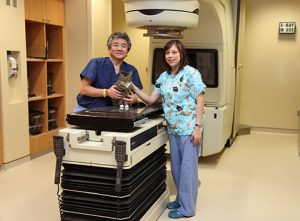Radiation Therapy Machines: Machines and Methods
Radiation Therapy Machines: Machines and Methods
 May is Pet Cancer Awareness Month. Since the goal of Pet Cancer Awareness Month is to educate pet owners about cancer, I am going to devote this week’s blog to clearing up some of the confusion over the various forms of radiation therapy. Radiation therapy machines treat cancer by delivering high energy radiation to a tumor, killing the tumor cells. There are several types of prescriptions for the dose of radiation delivered to a tumor.
May is Pet Cancer Awareness Month. Since the goal of Pet Cancer Awareness Month is to educate pet owners about cancer, I am going to devote this week’s blog to clearing up some of the confusion over the various forms of radiation therapy. Radiation therapy machines treat cancer by delivering high energy radiation to a tumor, killing the tumor cells. There are several types of prescriptions for the dose of radiation delivered to a tumor.
Radiation Oncologists and Their Machines
A number of different machines are available to administer radiation:
- The Animal Medical Center uses a Varian Clinac® linear accelerator (linac) to deliver radiation therapy to tumors. Our linac has a multi-leaf collimator (MLC) which moves while the radiation beam is on, sculpting the beam around the tumor, protecting normal structures from radiation. Here is a MLC in action. Radiation using a MLC is called image modulated radiation therapy (IMRT). We also can utilize a 3-dimensional computerized treatment planner. The AMC’s linac can also be used to deliver stereotactic treatments. I will expand on stereotactic treatment below.
- The Cyberknife® is a linac merged with a robotic arm, which allows the machine to dance around the patient. The radiation beam turns on and off, zapping the tumor from multiple angles. Treatment from multiple angles creates a treatment field conforming to the shape of the tumor.
- A Tomotherapy machine is a cross between a linac and a CT scan. Tomotherapy creates an image of the tumor immediately prior to treatment and uses the image to direct treatment. Both imaging and treatment occur using the same machine.
- The Gamma Knife® treats brain tumors. And although the word knife suggests this machine does surgery, it does not. It precisely delivers a high dose of radiation to a very focal area in the brain while avoiding normal brain tissue.
Radiation Therapy Prescriptions
Radiation can be prescribed in a number of different fashions. The standard for many years has been administration of multiple small doses of radiation with the goal of eradicating the tumor. This course of treatment is often referred to as “definitive” or “hyperfractionated” therapy. Oncologists commonly recommend this type of treatment to follow when a surgical procedure has not removed every last tumor cell. The opposite of hyper is hypo and oncologists often use a few large doses of radiation to treat tumors that cannot be removed by surgery. Oral melanoma is a good example of a tumor treated this way.
The most advanced dosing schemes for radiation therapy are Stereotactic Radiation Therapy (SRT), which includes both Stereotactic Radiosurgery (SRS) and Stereotactic Body Radiation Therapy (SBRT). Stereotactic treatments use high doses of radiation given over one to three treatments. On-board imaging equipment allows precise delivery of the radiation dose in stereotactic treatments. Stereotactic radiosurgery, like the Gamma Knife, is not a form of surgery. It is typically administered in a single dose and is reserved for treatment of brain tumors. Stereotactic radiosurgery was the first type of stereotactic radiation therapy. Stereotactic Body Radiation Therapy, as the name implies, is administered outside the brain. The AMC’s Clinac is able to deliver both SRS and SBRT.
The “Best” Type of Radiation Therapy
No one radiation therapy machine or prescription is “best.” The type appropriate to treat your pet’s tumor will be determined by the biopsy results, surgical resectability of the tumor, and size and location of the tumor. The AMC has a board certified radiation oncologist who can help you make the best decision possible to manage your pet’s cancer with radiation.

































